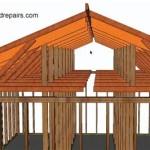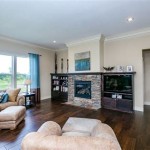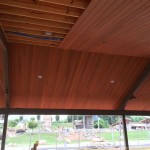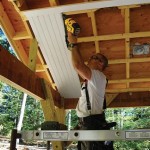What Is A Double Tray Ceiling?
A double tray ceiling, also known as a tiered tray ceiling, is an architectural feature that adds depth, dimension, and visual interest to a room. It is a variation of the standard tray ceiling, distinguished by having two recessed or inverted steps instead of just one. This design element creates a more elaborate and visually striking effect, often used in living rooms, dining rooms, bedrooms, and other spaces where a touch of elegance and sophistication is desired.
Understanding the construction and purpose of a double tray ceiling requires a grasp of basic ceiling design principles. A standard ceiling is a flat surface, while a tray ceiling introduces vertical variation by raising a central section of the ceiling, forming a "tray-like" recess. A double tray ceiling takes this concept further, incorporating a second, smaller tray within the larger one. This layered approach creates a sense of height and spaciousness, making the room feel larger and more open.
The visual impact of a double tray ceiling is considerable. It can transform a plain, unremarkable room into a focal point within the home. The multiple layers provide opportunities for creative lighting solutions, paint color variations, and decorative trim, further enhancing the aesthetic appeal of the space. The design can be customized to complement various architectural styles, from traditional to modern, making it a versatile option for different homes and preferences.
Construction and Design Considerations
The construction of a double tray ceiling involves careful planning and execution. It typically starts with framing the perimeter of the room with wood or metal studs. The first tray is then framed and attached to the existing ceiling joists. This creates the first level of the recess. The second, smaller tray is then framed and attached within the first tray, creating the second level of depth. Accurate measurements and precise cuts are crucial to ensure that the trays are level and aligned correctly. Drywall is then applied to the framed structure, covering the studs and creating a smooth, paintable surface.
The height of the ceilings is a crucial factor when considering a double tray ceiling. These types of ceilings are best suited for rooms with ceilings that are at least nine feet high, and ideally ten feet or more. Lower ceilings may not provide enough vertical space to accommodate the multiple layers of the tray without making the room feel cramped. The dimensions of the room also influence the size and shape of the trays. A large room can accommodate a larger, more elaborate double tray ceiling, while a smaller room may require a more subtle and scaled-down design.
Lighting is another important consideration. Double tray ceilings offer opportunities for creative lighting solutions that can enhance the visual impact of the design. Recessed lighting fixtures can be installed within the trays to provide ambient lighting. Accent lighting, such as LED strip lights or spotlights, can be used to highlight the different levels of the tray, creating a dramatic effect. A chandelier or pendant light can be hung from the center of the innermost tray, serving as a focal point and providing task lighting. Strategic placement of lighting fixtures can also help to accentuate architectural details and create a sense of depth and dimension.
The choice of materials and finishes also plays a significant role in the overall aesthetic of the double tray ceiling. Drywall is the most common material for the ceiling surface, as it is easy to work with and provides a smooth, paintable surface. However, other materials, such as wood planks, decorative tiles, or textured finishes, can also be used to add visual interest. The trim around the edges of the trays can be made of wood, plaster, or other materials, and can be painted or stained to match the décor of the room. The paint color can also be used to create visual contrast and highlight the different levels of the tray. A lighter color can be used on the innermost tray to make it appear taller and brighter, while a darker color can be used on the outer tray to ground the design and create a sense of depth.
Aesthetic and Functional Benefits
One of the main benefits of a double tray ceiling is its aesthetic appeal. It adds visual interest and architectural detail to a room, making it feel more elegant and sophisticated. The multiple layers of the tray create a sense of depth and dimension, which can transform a plain, unremarkable room into a focal point within the home. The design can be customized to complement various architectural styles, from traditional to modern, making it a versatile option for different homes and preferences.
Beyond its aesthetic appeal, a double tray ceiling can also enhance the functionality of a room. The raised ceiling can make a room feel larger and more open, creating a sense of spaciousness. This is particularly beneficial in rooms with low ceilings or limited natural light. The additional height can also improve ventilation and air circulation, making the room more comfortable. The trays can also be used to conceal ductwork, wiring, or other unsightly elements, creating a cleaner and more streamlined look.
Another functional benefit of a double tray ceiling is its ability to improve acoustics. The multiple layers of the tray can help to absorb sound waves, reducing echo and reverberation in the room. This can be particularly beneficial in rooms with hard surfaces, such as tile or hardwood floors, which tend to reflect sound. By improving acoustics, a double tray ceiling can create a more comfortable and enjoyable living environment.
The installation of a double tray ceiling can also increase the value of a home. It is considered a high-end architectural feature that can add appeal to potential buyers. It demonstrates attention to detail and a commitment to quality craftsmanship, which can make a home stand out from the competition. While the cost of installing a double tray ceiling can be significant, the long-term benefits in terms of aesthetics, functionality, and property value can make it a worthwhile investment.
Customization and Design Options
Double tray ceilings offer a wide range of customization and design options, allowing homeowners to create a unique and personalized look. The shape of the trays can be varied, from rectangular to oval to circular, depending on the shape of the room and the desired aesthetic. The size and depth of the trays can also be adjusted to create different visual effects. A deeper tray will create a more dramatic recess, while a shallower tray will be more subtle.
The finish of the ceiling can also be customized to suit the homeowner's taste. Smooth drywall is the most common option, providing a clean and modern look. However, textured finishes, such as stucco or Venetian plaster, can also be used to add visual interest and create a more rustic or traditional feel. The ceiling can also be painted in a variety of colors, from neutral tones to bold hues, to complement the décor of the room. The use of different paint colors on the different levels of the tray can create a striking visual effect.
Decorative trim can also be added to the edges of the trays to enhance the design. Crown molding is a popular choice, adding a touch of elegance and sophistication. Other types of trim, such as rope molding, beadboard, or geometric patterns, can also be used to create a unique and personalized look. The trim can be made of wood, plaster, or other materials, and can be painted or stained to match the décor of the room.
Lighting is another key element in the design of a double tray ceiling. Various lighting fixtures can be used to create different effects, from ambient lighting to accent lighting to task lighting. Recessed lighting is a popular choice for providing ambient lighting, as it is discreet and provides a uniform illumination. LED strip lights can be installed along the edges of the trays to create a soft, glowing effect. Spotlights can be used to highlight architectural details or artwork. A chandelier or pendant light can be hung from the center of the innermost tray, serving as a focal point and providing task lighting. The placement and type of lighting fixtures can be carefully chosen to create a specific mood or atmosphere in the room.
The choice of materials, finishes, trim, and lighting can all be combined to create a double tray ceiling that is both aesthetically pleasing and functionally sound. By carefully considering these design options, homeowners can create a unique and personalized space that reflects their individual style and preferences.

What You Need To Know About Tray Ceilings Jesse Steed Realtor

Double Tray Ceiling Add Crown Moulding To Really Make It Pop

Coffered Ceiling Installation Monks Home Improvements

Superb Tray Ceiling Designs For Your Living Spaces

Double Tray Ceiling Traditional Bedroom Dallas By Kasper Custom Home Remodeling Houzz Ie

Tray Ceilings The Good Bad Truly Hideous Laurel Home

Double Tray Ceiling

Trey Ceiling Ideas To Level Up Any Room

Superb Tray Ceiling Designs For Your Living Spaces

Trey Ceiling Ideas To Level Up Any Room
Related Posts








